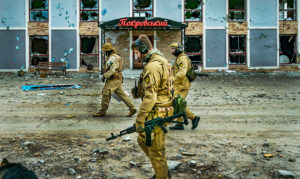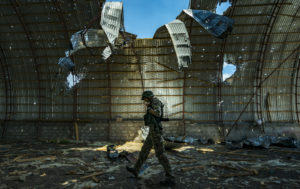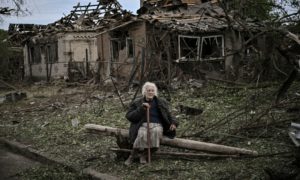When I lived on Kyiv’s main boulevard, Khreschatyk, in 2014, I often wondered what it would be like to see Russian tanks rolling down its centre. Last week, I found out, after residents sent me photos of the Ukrainians parading captured Russian tanks down that very street to celebrate their impending Independence Day.
The message was clear. The Russians thought that Ukraine would fold within three days. They thought they would be parading down Khreschatyk in triumph. So Kyiv gave them their parade — albeit with a twist. One thing I’ve always liked about Ukrainians (and to be fair, many Russians, too) is their sense of humour.
This year, Independence Day also falls on the six-month anniversary of the war. If the people here needed a reminder about the importance — and indeed price — of freedom, they couldn’t have asked for a better or more visceral one. For this, and many other reasons, today’s celebrations have a more intense meaning for Ukrainians.
“We got our official independence in 1991 — more than 90% of people voted for it,” Hanna Shelest, Director of Security Programmes at the Foreign Policy Council’s Ukrainian Prism, tells me. “But without any struggle, there was little appreciation of what it really meant. Since February, there is almost no one who does not understand.”
Independence has become for Ukrainians about more than just protecting their land. It is about self-identification. It is no longer just a political act. It is a historical return to their roots, which were repressed for so long. As Shelest says: “Independence is also now psychological — a feeling that we are different from modern-day Russians who consider themselves post-Soviet, whereas we consider ourselves Western and concerned with the future not the past. We are ready to die to escape from a despot rather than worship him.”
If the truth of her words is plain to see six months on, then it is in the country’s southeast that we can best try to determine how many more Ukrainians might have to die for their freedom. Things haven’t changed all that much since I last reported from here this year. Air raid sirens still howl. Russian artillery still pounds army positions and cities. The targets are still overwhelmingly civilian. The Russians half-heartedly lob rockets at Odesan houses and malls. In Mykolaiv, 100km northeast, their barrage is relentless: their goal here is to create a second Mariupol. In Zaporizhzhya, Russian forces turned Europe’s largest nuclear power plant into a battlefield.
Yet Kherson remains the most important city on the most important front of the war right now. The Russians have occupied it since the first days of the war — with difficulty. Resistance activity is never-ending and, occasionally, deadly. As long as the Russians have to worry about Kherson, their chances of taking Mykolaiv, and with it the broader south, are greatly reduced.
The city is also a barometer of the changing war in microcosm. Inside Kherson, you can map the evolving success — and changing justification — of Russia’s war in Ukraine. When the Russians arrived in spring their message to the locals was clear: “We are one people. Let’s unite.” It didn’t fly. And as autumn approaches, the Kremlin has changed tack. “Now they have switched up the messaging to push information about benefits,” says a source on the ground. “They’re keen to let the people know that Russia is generous with its agricultural credits; that it can provide cheaper pesticides; and that the market for agricultural produce is far larger there than in Ukraine.”
As ever, the elderly are a key target audience for their propaganda. It is with them that lingering memories of the Soviet Union, many of them fond, are found. As ever, the focus is largely on pensions. Since occupying the city, the Russians have closed Ukrainian banks and banned the Hryvnia, making it impossible for locals to collect their cash. They have now opened a pension fund office and are also upscaling local administrative and social services — not least by employing more people in local government. “Indirect bribery is one of their main instruments now,” says one resident, drily.
This now extends to all areas — most of all education. Schools reopen in September and right now most Ukrainians in Kherson don’t want their kids to return. With Moscow sending in Russian teachers to teach them a Kremlin-approved syllabus, parents have been keeping their children home to learn online with the Ukrainian syllabus instead. Yet now, the local authorities are offering financial support for books and uniforms; anything to get them through the door.
“There are around 60 schools in the Kherson region,” I’m told. “Russia says it will open 10 more in September, but I’m doubtful. Not more than three I reckon. We know the Russians want to bring more teachers and doctors to Kherson, but they are being prevented from doing this because of a significant intensification of Ukrainian artillery.”
As the war for Kherson’s “hearts and minds” stalls alongside its military operations, the Russians are now ramping up their information operations. The focus now is on producing local content, albeit often of poor quality. No longer happy to merely pump Russian TV into the city, they’ve now opened a local channel and several local newspapers — and, like all good propagandists, are distributing them free of charge. Also making its way into the city is the Russian newspaper Komsmolskaya Pravda, which traditionally has local supplements in the many areas it is distributed. Today, it has a Kherson edition. The Russians are in it for the long haul.
The next key date in the war is 11 September. There will be elections in Russia, and it is widely expected that Moscow will plan a series of bogus referendums across the occupied areas. The goal, as it was with Crimea, is to give a veneer of democratic legitimacy to its project of imperialism and genocide.
For Kherson, though, doubts remain. “We assess that the Russians will have difficulty holding a referendum inside the city [if not elsewhere across the region],” says my source. “It will be hard for them to organise it given the resistance activity inside the city. We know that several weeks ago the Kherson election committee sent a few people to Russia for training but have heard nothing since.”
Elsewhere in the lead up to today’s celebrations, there has been chatter, both in the Ukrainian resistance and the West more broadly, of an imminent counter-offensive, and even the recapture of Kherson within weeks. Those I’ve spoken to on the ground are hesitant because, over the last few days, the Russians have also started counter-attacking. Instead of seven battalions they now have 22 battalions in the region.
For the resistance, every day that the city doesn’t fall into the hands of Russia is a victory. That is their focus. If the results of the war remain in doubt, the resolve of the Ukrainians is not. Putin wanted to destroy the Ukrainian state in a matter of days. Instead, six months on, he has succeeded only in helping to build the Ukrainian nation.
Disclaimer
Some of the posts we share are controversial and we do not necessarily agree with them in the whole extend. Sometimes we agree with the content or part of it but we do not agree with the narration or language. Nevertheless we find them somehow interesting, valuable and/or informative or we share them, because we strongly believe in freedom of speech, free press and journalism. We strongly encourage you to have a critical approach to all the content, do your own research and analysis to build your own opinion.
We would be glad to have your feedback.
Source: UnHerd Read the original article here: https://unherd.com/




